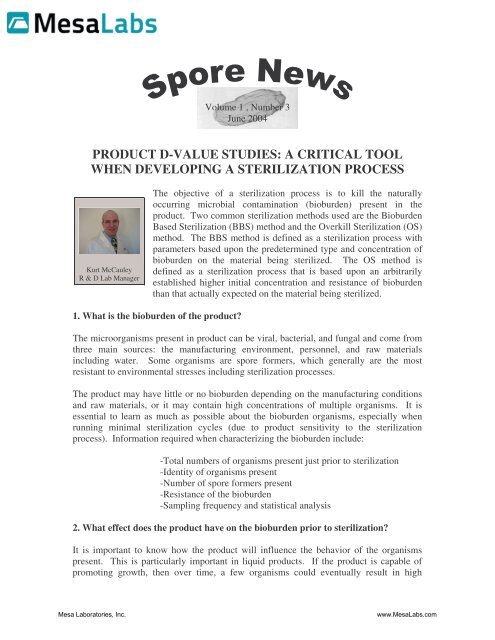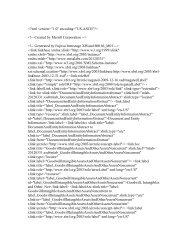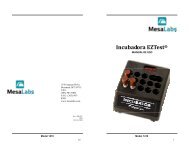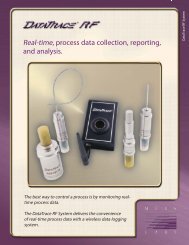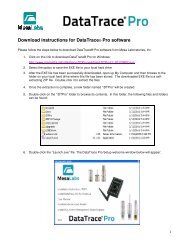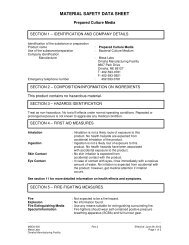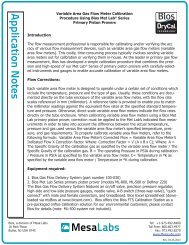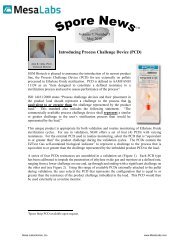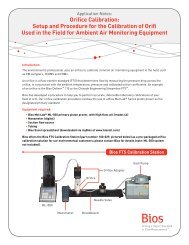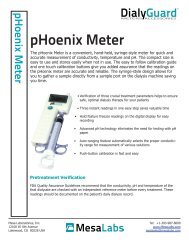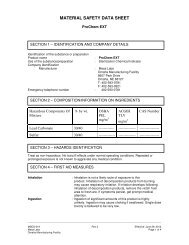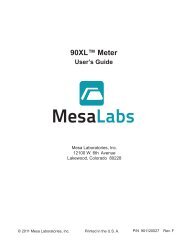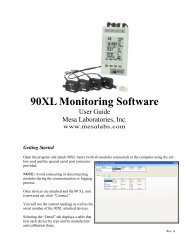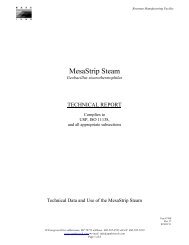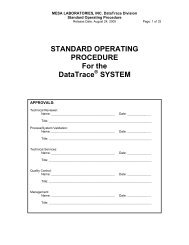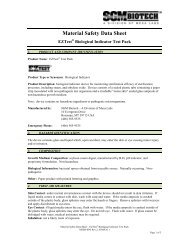Sporenews v1 n3 D-value Studies - Mesa Labs
Sporenews v1 n3 D-value Studies - Mesa Labs
Sporenews v1 n3 D-value Studies - Mesa Labs
Create successful ePaper yourself
Turn your PDF publications into a flip-book with our unique Google optimized e-Paper software.
Volume 1 , Number 3<br />
June 2004<br />
PRODUCT D-VALUE STUDIES: A CRITICAL TOOL<br />
WHEN DEVELOPING A STERILIZATION PROCESS<br />
Kurt McCauley<br />
R & D Lab Manager<br />
The objective of a sterilization process is to kill the naturally<br />
occurring microbial contamination (bioburden) present in the<br />
product. Two common sterilization methods used are the Bioburden<br />
Based Sterilization (BBS) method and the Overkill Sterilization (OS)<br />
method. The BBS method is defined as a sterilization process with<br />
parameters based upon the predetermined type and concentration of<br />
bioburden on the material being sterilized. The OS method is<br />
defined as a sterilization process that is based upon an arbitrarily<br />
established higher initial concentration and resistance of bioburden<br />
than that actually expected on the material being sterilized.<br />
1. What is the bioburden of the product?<br />
The microorganisms present in product can be viral, bacterial, and fungal and come from<br />
three main sources: the manufacturing environment, personnel, and raw materials<br />
including water. Some organisms are spore formers, which generally are the most<br />
resistant to environmental stresses including sterilization processes.<br />
The product may have little or no bioburden depending on the manufacturing conditions<br />
and raw materials, or it may contain high concentrations of multiple organisms. It is<br />
essential to learn as much as possible about the bioburden organisms, especially when<br />
running minimal sterilization cycles (due to product sensitivity to the sterilization<br />
process). Information required when characterizing the bioburden include:<br />
-Total numbers of organisms present just prior to sterilization<br />
-Identity of organisms present<br />
-Number of spore formers present<br />
-Resistance of the bioburden<br />
-Sampling frequency and statistical analysis<br />
2. What effect does the product have on the bioburden prior to sterilization?<br />
It is important to know how the product will influence the behavior of the organisms<br />
present. This is particularly important in liquid products. If the product is capable of<br />
promoting growth, then over time, a few organisms could eventually result in high<br />
<strong>Mesa</strong> Laboratories, Inc.<br />
www.<strong>Mesa</strong><strong>Labs</strong>.com
numbers of organisms. This presents a problem if there is a significant time delay<br />
between manufacture and sterilization. High numbers of organisms could result in an<br />
increase in sterilization time. Alternately, the material may be bacteriostatic, bactericidal,<br />
sporostatic, or sporicidal.<br />
Properties of the material being sterilized (e.g. chemistry of a pharmaceutical product or<br />
the physical characteristics of a medical device) can have a significant influence on the<br />
resistance of the microorganisms. The product may protect the organisms in numerous<br />
ways such as by coating them or causing them to clump, increasing their resistance to the<br />
sterilization process. Alternately, it may make them more susceptible to the sterilization<br />
process.<br />
Figure 1 displays single free floating spores, while Figure 2 displays several large<br />
clumps, some of them containing hundreds of spores.<br />
Figure 1. Unclumped Spores in Ethanol<br />
Figure 2. Clumped Spores in Product<br />
<strong>Mesa</strong> Laboratories, Inc.<br />
www.<strong>Mesa</strong><strong>Labs</strong>.com
3. Why is it acceptable to base sterilization cycles on the resistance of Geobacillus<br />
stearothermophilus spores?<br />
Geobacillus stearothermophilus (ATCC #7953) spores (which typically have D 121 -<strong>value</strong>s<br />
in the 1.5-2.5 minute range on a paper strip) are more resistant than most wild type<br />
organisms. These spores, widely used for monitoring steam sterilization processes, may<br />
be substituted for the bioburden organism during resistance testing. When this<br />
substitution occurs, it is assumed that the G. stearothermophilus spores are more resistant<br />
than the bioburden organisms or by design significantly out number the bioburden<br />
organisms. The kill time for the G. stearothermophilus would then exceed the kill time<br />
for the bioburden organisms. The following chart illustrates this point.<br />
Population<br />
1.00E+07<br />
1.00E+06<br />
1.00E+05<br />
1.00E+04<br />
1.00E+03<br />
1.00E+02<br />
1.00E+01<br />
2.00E+06<br />
1.00E+05<br />
2.00E+04<br />
1.00E+02<br />
Bioburden<br />
G.stearothermophilus<br />
9.00E+03<br />
2.00E+02<br />
1.00E+01<br />
1.00E+00<br />
1.00E+00<br />
0 2 4 6 8 10 12 14<br />
Exposure Time in Minutes<br />
4. Is it acceptable to base sterilization cycles on the resistance of other organisms?<br />
Other organisms such as Bacillus coagulans (ATCC #7050), B. smithii (formerly B.<br />
coagulans ATCC #51232), B. subtilis “5230” (ATCC #35021) and Clostridium<br />
sporogenes (ATCC #11437) may be used in certain situations. These organisms are more<br />
sensitive to moist heat sterilization than G. stearothermophilus, but in general, they are<br />
still more resistant than the bioburden. It may be desirable to use one of these organisms<br />
when the product is sensitive to the sterilization process, thereby limiting the sterilization<br />
time. However, when working with a heat sensitive product, it is strongly recommended<br />
that the bioburden be characterized prior to basing sterilization parameters on the above<br />
mentioned indicator organisms.<br />
5. Why perform a D-<strong>value</strong> study?<br />
The most direct method for evaluating the resistance of the test organism (a bioburden<br />
isolate or G. stearothermophilus spores) is by performing a D-<strong>value</strong> study. When<br />
<strong>Mesa</strong> Laboratories, Inc.<br />
www.<strong>Mesa</strong><strong>Labs</strong>.com
evaluating the bioburden, it is not necessary to test every organism isolated, only the most<br />
resistant (which can be isolated though the use of a heat shock screening procedure).<br />
6. How are D-<strong>value</strong> studies performed?<br />
Ideally, the D-<strong>value</strong> study should be performed on the actual product spiked with the test<br />
organism. Biological Indicator Evaluator Resistometers (B.I.E.R.) vessels 1,2 , sterilizers<br />
capable of running square wave cycles, are commonly used in D-<strong>value</strong> studies.<br />
D-<strong>value</strong>s can be calculated by using one of two methods, survivor curve or fraction<br />
negative analysis. A survivor curve plots the surviving microorganisms against a critical<br />
process parameter, usually time. The curve provides an important graphic representation<br />
of the kinetics of the microbicidal process 3 . Fraction negative analysis, sometimes<br />
referred to as “end-point experiments”, focuses on the quantal zone (the area where<br />
exposures to replicate units result in both positive and negative units when cultured for<br />
growth) 4 .<br />
In general, a survivor curve establishes the resistance for surviving populations greater<br />
than 5 x 10 1 whereas the fraction negative method establishes the resistance for surviving<br />
populations below 5 x 10 0 .<br />
There are two advantages to the survivor curve method. One is that it can demonstrate a<br />
log linear regression curve when doing product testing, which can be extrapolated to<br />
demonstrate the calculated SAL. The other is that the product can be removed through<br />
filtration so as to eliminate any potential product inhibition on the injured spores.<br />
SGM has years of experience performing these studies on a wide variety of<br />
pharmaceutical products for R&D and commercial manufacturers.<br />
To have a study performed the manufacturer will need to supply approximately 100 ml of<br />
product and a slant containing the bioburden isolate. SGM can supply spores (traceable<br />
to American Type Culture Collection) if a bioburden study is not desired. A typical study<br />
consists of 1) inoculating the product with the test organism, 2) filling and sealing the<br />
spiked product into very small glass ampoules, 3) performing graded exposures on the<br />
ampoules in a B.I.E.R. vessel, and 4) assaying the ampoules for surviving spores. The<br />
data collected from these exposures is used to calculate a D-<strong>value</strong>. Please contact SGM<br />
Biotech, Inc. for a detailed protocol.<br />
1 AAMI Guideline for the use of ethylene oxide and steam biological indicators in industrial sterilization<br />
processes. ST34<br />
2 ISO/CD 18472, Sterilization of health care products – Biological and chemical indicators – Test<br />
equipment and methods. Draft.<br />
3 ISO 11138-1:1994(E) Annex B.<br />
4 ISO 11138-1:1994 (E) Annex C.<br />
<strong>Mesa</strong> Laboratories, Inc.<br />
www.<strong>Mesa</strong><strong>Labs</strong>.com
These D-<strong>value</strong>s can be used to calculate an appropriate SAL for the sterilization process.<br />
SGM can also provide a convenient BI challenge, which complements these studies for<br />
routine monitoring of the sterilization process.<br />
Please email us with topics you would like to see addressed in “Spore News”.<br />
<strong>Mesa</strong> Laboratories, Inc.<br />
www.<strong>Mesa</strong><strong>Labs</strong>.com


